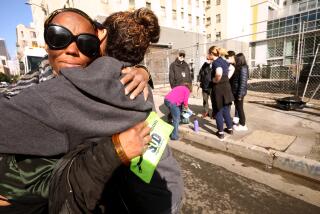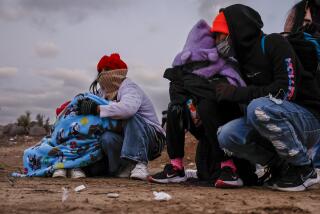Doctor Makes House Calls to Misery Abroad
- Share via
Deborah Milligan looks the part of the Southern California surfer girl.
With her blond hair tied back into a ponytail, her tan skin draped in linen and beachcombing flip-flops on her feet, she could blend right in with the denizens of her native Newport Beach.
But for more than a year, Milligan saw more funerals than barbecues, and her feet traversed muddy, potholed roads rather than the fine grain of Pacific beaches. Going shopping, she would pass stacks of homemade caskets rather than cases of beer, and fears of catching the common cold were replaced by anxiety over contracting malaria.
Milligan, 41, a physician specializing in pulmonary and critical care, recently returned from Homa Bay, Kenya, as one of thousands of volunteers who each year travel the globe as part of Doctors Without Borders.
Milligan, who lives in Long Beach, spent 15 months in the region, serving in the general medical wards, the tuberculosis ward and the chest clinic of the Homa Bay District Hospital. She also worked in an HIV clinic, which, when it was opened by Doctors Without Borders in November 2001, was the only clinic in Kenya providing free anti-retroviral therapy for people with AIDS. Milligan was one of the organization’s four non-Kenyan doctors tending the hospital’s overflowing roster of patients.
“In one sense, it was really depressing to be there, there was so much death,” she said. “But on the flip side, we were able to do so much more for patients than they would have gotten in other hospitals.”
Doctors Without Borders, known more commonly throughout the world as Medecins Sans Frontieres, was founded in 1971 by a group of French physicians seeking to provide medical care to victims of armed conflict, epidemics and natural disasters.
The nonprofit organization, which now sends more than 2,500 doctors, nurses, lab technicians, clinical psychiatrists and administrators each year to 80 countries, received the Nobel Peace Prize in 1999.
Milligan got her passion for medicine from her father, an Anaheim neurologist. She got her first taste of living outside the U.S. while attending Occidental College and taking part in a summer program in Africa. She knew she wanted to study medicine, but after she earned her bachelor’s degree, she decided to take a few years off. Dedicated to helping others, she worked for three years as a technician in a tissue bank in San Pedro, helping burn victims with tissue transplants.
Milligan attended medical school at the University of Virginia. She returned to California to do her residency at UC Davis and a fellowship at Harbor-UCLA Medical Center in Torrance.
She spent a couple of years working at St. Mary’s Hospital in Long Beach but found herself getting burned out by the long hours. She started looking into different organizations and found Doctors Without Borders. Her tuberculosis expertise landed her a mission in Nagorno-Karabakh, a republic of Azerbaijan.
While there, Milligan worked in a pilot program for patients with multi-drug-resistant tuberculosis. She treated society’s forgotten: drug abusers, schizophrenics, the poor and former prisoners.
The experience introduced her to practicing medicine amid political strife. The Armenian enclave, formerly controlled by the Soviet Union, has been fought over by the Azeris and Armenians, and the conflict has left thousands dead. Milligan said she loved the area and its people, but danger wasn’t far away, with land mines dotting the landscape around her.
After nine months, Milligan’s mission ended and she was ready for a similar one in the former Soviet republic of Georgia. When a U.N. helicopter was shot down over Georgia, the mission was canceled and Milligan suddenly found herself in Kenya.
Homa Bay has the highest incidence of HIV in Kenya, with more than 30% of the population infected. More than 2,000 people registered with the Homa Bay clinic and Milligan would see 35 to 40 patients every day.
“In Homa Bay, there are more poor, and you see more death,” she said. “In Nagorno-Karabakh, I had one or two patients die. In Homa Bay, there were funerals all the time.”
Milligan and the other volunteers could do only so much, and limited resources strained their work. Doctors Without Borders estimates that more than 7,000 Homa Bay residents will need to receive anti-retroviral care in the near future. The clinic cannot handle that caseload and will probably have to turn away new patients soon, Milligan said.
“That’s the really depressing thing,” she said. “If the clinic closes and we can’t refer them anywhere else, there’s nowhere else for them to go. It’s really a challenge running these programs.”
But as AIDS continues to ravage the country, the importance of starting such programs as the Homa Bay clinic is heightened, said Dr. Brigg Reilley, an epidemiologist and program officer for Doctors Without Borders.
“Deb’s mission -- the challenge of meeting the AIDS epidemic -- provides as much challenge as anyone can expect to take on,” he said. “With pilot programs like Homa Bay, you take the lessons learned and start thinking of national treatment programs. That’s why projects like Deb’s are so pivotal.”
Still, the work can be frustrating. Volunteers work long hours, often in dire conditions. They receive a monthly stipend to cover living expenses and little else. It can be a tough ride.
“Unlike here, they can’t go down the hall and talk about an emotional day with friends and family,” he said.
These days, Milligan is slowly readjusting to life back in California. She said she still feels passionate about the organization but wanted to come back to spend time with her family and retake her medical boards, which expire next year.
In August she began a new job at Long Beach Memorial Medical Center, employed by HealthCare Partners Medical Group. She said she will remain involved with Doctors Without Borders and may take on another mission someday.
“We have a moral and ethical responsibility to think about the outside world,” she said.
In the meantime, she plans to use her experiences in Azerbaijan and Kenya to invigorate the field of medicine in the U.S.
“I appreciate what we can do for people here a lot more now,” she said. “A lot of doctors here are discouraged with medicine because of all the lawsuits and the paperwork that has to be done. I think I might be more tolerant now.”
More to Read
Sign up for Essential California
The most important California stories and recommendations in your inbox every morning.
You may occasionally receive promotional content from the Los Angeles Times.










